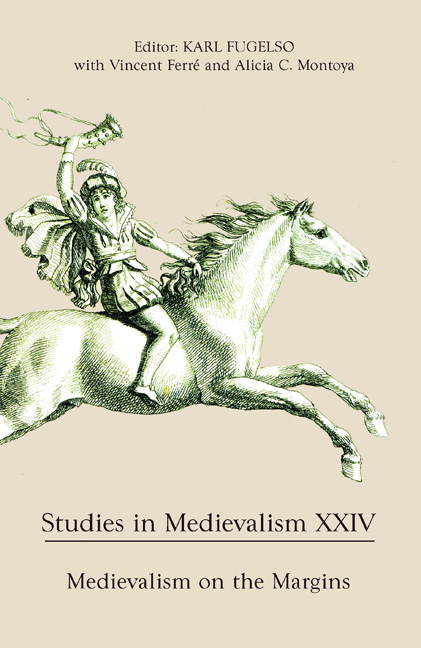Book contents
- Frontmatter
- Acknowledgments
- Contents
- List of Illustrations
- Volume XXIV 2015
- Editorial Note
- I Medievalism on the Margins: Some Perspective(s)
- 1 Medievalism in the Margins: Paratexts and the Packaging of Medieval French Literature
- 2 Medievalism Studies and the Subject of Religion
- 3 Pop Medievalism
- 4 Ecomedievalism: Applying Ecotheory to Medievalism and Neomedievalism
- 5 Whiteness and Time: The Once, Present, and Future Race
- 6 A Desire for Origins: The Marginal Robin Hood of the Later Ballads
- 7 Women, Queerness, and Massive Chalice: Medievalism in Participatory Culture
- 8 “Constant inward looking,” Medieval Devotional Literature, and the Concordium-Fruitlands Library
- II Trans-Atlantic Medievalism(s)
- III Other Interpretations
- Contributors
2 - Medievalism Studies and the Subject of Religion
from I - Medievalism on the Margins: Some Perspective(s)
Published online by Cambridge University Press: 05 December 2015
- Frontmatter
- Acknowledgments
- Contents
- List of Illustrations
- Volume XXIV 2015
- Editorial Note
- I Medievalism on the Margins: Some Perspective(s)
- 1 Medievalism in the Margins: Paratexts and the Packaging of Medieval French Literature
- 2 Medievalism Studies and the Subject of Religion
- 3 Pop Medievalism
- 4 Ecomedievalism: Applying Ecotheory to Medievalism and Neomedievalism
- 5 Whiteness and Time: The Once, Present, and Future Race
- 6 A Desire for Origins: The Marginal Robin Hood of the Later Ballads
- 7 Women, Queerness, and Massive Chalice: Medievalism in Participatory Culture
- 8 “Constant inward looking,” Medieval Devotional Literature, and the Concordium-Fruitlands Library
- II Trans-Atlantic Medievalism(s)
- III Other Interpretations
- Contributors
Summary
In 2013, Cynthia Cyrus published a monograph entitled Received Medievalisms: A Cognitive Geography of Viennese Women's Convents in Palgrave's “The New Middle Ages” series. In her study, Cyrus describes and examines the complex cultural history of reception of women's monastic communities from the Ottoman siege of Vienna in 1529 through the nineteenth century. Focusing mainly on Augustinian, Premonstratensian, Clarissan, Penitent, and Cistercian monastic houses, she investigates an extensive panoply of multimodal references (visual: as in cartographical plans and various pictorial representations; verbal: as in travel literature, topographies, anecdotes, and legends) and fully fledged “foundation stories” (formal histories told to relate the origins of a specific community), to present readers with the urbanhistorical background for the evolving attitudes toward the city's past. While the women's convents:
lack the quaintness of the Viennese fiaker, they substitute their own enacted ritual of liturgy for the whirl of the waltz with its emphasis on imperial and urban pleasures. Thus, they do not partake directly in the theme of “gay Vienna.” These institutions do, however, capture a sense of the Viennese past that generated its own sense of longing and belonging. The convents, as portrayed in a range of post medieval genres, function as easily recognizable symbols of the medieval and the spiritual ancestry of a proud city, though how they do so can vary according to narrative preference and authorial perspective. With enduring walls of stone and an ongoing presence in everyday religious life, the monasteries could stand directly for the “old” and for the “Catholic” nature of the city, skyline markers of a historical Christian past. (2)
Cyrus's project is exceptional in several ways. First of all, it focuses for the most part on early modernity, a time period in which the concept of the medieval past was yet unsettled.
- Type
- Chapter
- Information
- Studies in Medievalism XXIVMedievalism on the Margins, pp. 11 - 20Publisher: Boydell & BrewerPrint publication year: 2015

